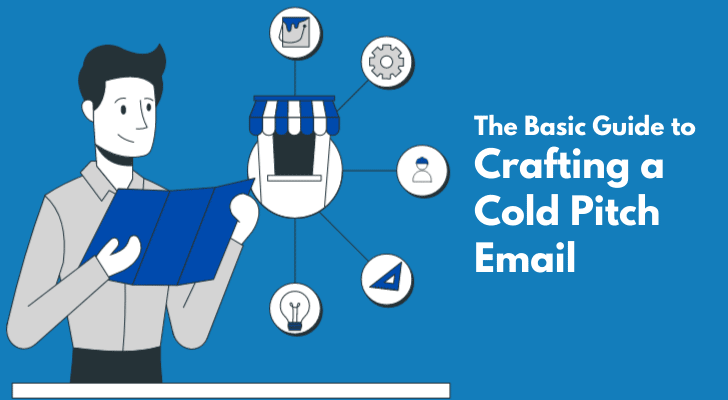Are you looking to reach out to potential clients or investors but don't know where to start? Crafting a cold pitch email can be daunting, but it's a skill for any entrepreneur or freelancer to learn. The perfect cold pitch email can open doors and lead to exciting opportunities.
But how do you write one that stands out from the crowd without sounding fake? Let me walk you through the steps of creating a persuasive cold pitch email that gets results. Whether you're new to pitching or just looking for some fresh ideas, read on.

What is a Cold Pitch Email?
A cold pitch email is a message that you send to someone who has no prior relationship with you or your business. It's essentially a sales pitch but in the form of an email. The goal of a cold pitch email is to introduce yourself and your product or service in the hopes that the recipient will be interested enough to respond.
Writing a cold pitch email can be challenging, as it requires careful consideration of several elements such as subject line, opening sentence, value proposition, call-to-action and more. An effective cold pitch should capture the reader's attention within seconds and provide them with something valuable they can't resist.
And let’s face it, not all recipients will respond positively - some may ignore your message altogether while others might mark it as spam. So you do need to create a personalized message tailored specifically for their pain points.
In general, sending out well-crafted cold pitch emails can help businesses expand their reach and generate new leads without having to rely solely on traditional methods like advertising or referrals. So if you're looking to grow your customer base or establish relationships with new prospects then mastering this communication skill could be very beneficial.
So It's Essentially Spam, Isn't It?
Yes, there's a very thin line between a cold pitch email and spam. The difference is supposed to be;
A cold pitch email:
A targeted communication with the purpose of initiating a business relationship, exploring potential opportunities, or proposing a collaboration. It is personalized, relevant, and tailored to the recipient's needs or interests.
The intent is to provide value, demonstrate understanding, and establish a genuine connection. Cold pitches follow best practices, respect regulations, and aim to build relationships based on mutual benefit.
Spam:
Spam refers to unsolicited emails sent in bulk without the recipient's consent or prior relationship. Spam emails are typically generic, lack personalization, and often promote irrelevant products, services, or scams. They often violate regulations and use deceptive tactics.
The primary goal of spam is self-promotion or malicious intent, disregarding the recipient's context or preferences.
However...
A lot of spammers may attempt to deceive recipients by pretending to have done thorough research and understanding. They may include seemingly personalized details in their messages to appear more genuine.
Likewise, there are instances where cold-pitch email senders may lack proper research and understanding of the recipient's background, needs, or challenges.
The distinction between spammers and legitimate cold-pitch email senders lies in their overall approach, intent, and adherence to ethical practices. While it is possible for spammers to mimic personalization and understanding, their primary goal remains self-promotion or malicious intent. They often send unsolicited messages in bulk without regard for permission or relevance.
On the other hand, legitimate cold-pitch email senders who follow best practices strive to provide value and establish a genuine connection. They may invest time in researching the recipient, tailoring their message to demonstrate relevance, and offering solutions or opportunities that align with the recipient's interests or challenges. Their intent is to initiate a meaningful conversation or business relationship based on mutual benefit.
While it's true that many legitimate email senders may lack proper research and understanding, it does not necessarily classify all cold pitches as spam. Effective cold pitches involve genuine efforts to engage with the recipient and offer value. It's important for senders to ensure they have a legitimate reason for reaching out and to personalize their message based on genuine insights.
Ultimately, the line between spam and legitimate cold-pitch emails can sometimes be blurred, and senders should be mindful of ethical practices and recipient preferences to differentiate themselves from spammers.
How to Write a Cold Pitch Email
To send a cold pitch email that doesn't appear to be spam, here are some effective strategies:
- Personalize the email: Address the recipient by name and mention something specific about their work or achievements. Avoid generic templates or copy-pasting, as personalization should go beyond superficial details.
- Establish relevance: Clearly explain how your product or proposal aligns with the recipient's needs or challenges. Highlight the potential value and benefits they can gain from your offering.
- Keep it concise and focused: Make your email easy to read and understand by keeping it concise and to the point. Avoid overwhelming the recipient with excessive information or lengthy paragraphs.
- Provide social proof: Include relevant testimonials, case studies, or success stories from previous clients or partners to build credibility and demonstrate your expertise.
- Show respect for their time: Acknowledge that their time is valuable and express your intention to be brief. Be mindful of the recipient's schedule and avoid overwhelming them with a lengthy email.
- Follow email etiquette: Use proper grammar, spelling, and formatting to present yourself professionally. Avoid using excessive capitalization, exclamation marks, or aggressive language that may resemble spam.
- Use a reputable email service: Sending cold pitch emails through a reputable email service provider (such as AWeber and GetResponse) can improve email deliverability and avoid being flagged as spam.
- Seek permission when appropriate: If applicable, consider asking for permission to send further information or updates. This helps establish a foundation of consent and builds a more positive relationship.
- Respect opt-out requests: If a recipient requests to unsubscribe or opt out of future emails, honor their request promptly and ensure they are removed from your mailing list.
Remember, the key is to approach your cold pitch email with professionalism, respect, and a genuine desire to provide value. By following these practices, you can increase the chances of your email being received positively and not mistaken for spam.
Examples of Cold Pitch Emails
Now that you know what a cold pitch email is and how to write one, it's time to take a look at some examples. These examples will give you an idea of the different approaches you can take when crafting your own cold pitch email.
Firstly, let's examine an example of pitching a guest post (which we receive a lot):
Subject line: Guest Post Submission - [Your blog name]
Hi [Recipient’s Name],
I am writing to inquire about submitting a guest post on your blog. As an avid reader, I believe my content would be valuable to your audience. The article I have in mind is titled "25 Steps to Create a Winning Chatbot Strategy".
I understand that you receive numerous pitches daily, but here are three reasons why my article stands out:
- It provides actionable tips that readers can implement right away.
- It caters specifically to small businesses looking to increase their social media presence.
- It includes real-life case studies from successful entrepreneurs.
If this sounds like something of interest please let me know and we'll discuss further details.
Best regards,
[Your Name]
Secondly, here's an example of how someone might pitch freelance services:
Subject line: Inquiring About Freelance Opportunities - [Company Name]
Dear [Recipient’s Name],
My name is Chantelle Di Stardust and I'm reaching out because I noticed on LinkedIn that [company name] may need support with their digital marketing efforts. With over five years of experience in the industry working with companies such as CyberCash Worldwide LLC, I can bring immense value through strategic planning & executing campaigns across various channels including SEO, PPC & Social media platforms.
You can find the testimonials from some of my happy customers here [link].
If there are any upcoming projects or opportunities available where my skills could contribute towards increasing ROI or generating leads/customers for clients then please feel free to get back in touch at your earliest convenience so we can discuss further details around requirements/expectations!
Thanks,
Best regards,
Chantelle
Here's another example of pitching a product or idea:
Subject line: [Product/Service Name] - An Innovative Solution for [Company Name]
Dear [Recipient’s Name],
I hope this email finds you well. I am writing to introduce you to an innovative product/service that could significantly benefit your company.
At [Your Company], we have developed [Product/Service Name], a revolutionary solution that helps businesses save time and money while increasing productivity. Our product is specifically designed for companies like yours, which are looking to streamline their operations and improve customer experience.
We'd love the opportunity to discuss how our product/service can help your business reach its goals. I'm available at your convenience for a phone call or video chat to discuss this further.
Thank you for your time and consideration. I look forward to hearing from you soon!
Sincerely,
[Your Name]

Dos and Don’ts of Writing a Cold Pitch Email
Here are some dos and don'ts to help you craft the perfect pitch:
Dos:
Don'ts:
Follow these dos and don'ts, you can increase the chances of receiving positive responses and building meaningful connections.
How to Follow Up After Sending a Cold Pitch Email

Following up after sending a cold pitch email is crucial to maximizing your chances of getting a response. Here's a step-by-step guide on how to effectively follow up:
- Give it time: Allow a reasonable amount of time for the recipient to read and respond to your initial email. The timeframe can vary depending on the nature of your pitch and the recipient's typical response time. Typically, waiting around one week is appropriate.
- Craft a concise follow-up email: Keep your follow-up email brief and to the point. Summarize the main points of your initial email and reiterate the value you can provide. Use a clear subject line that references your previous email.
- Show understanding and curiosity: Express understanding that the recipient might be busy and acknowledge their competing priorities. Show genuine curiosity about their thoughts on your proposal or any further questions they may have.
- Offer a reminder: Include a gentle reminder about your initial email to jog their memory. Refer to specific points or details mentioned in the previous email to help them connect the dots.
- Provide additional information: If you have any new information or updates since your initial email that may be relevant to the recipient, include it in the follow-up. This can further demonstrate your expertise or reinforce the value you can offer.
- Respectfully ask for a response: Clearly request a response from the recipient, whether it's to schedule a call, arrange a meeting, or simply express their interest or feedback. Be polite and avoid sounding demanding or pushy.
- Follow up again (if necessary): If you don't receive a response to your follow-up email within a reasonable timeframe (around one week), you may send one additional follow-up. However, be cautious not to overdo it, as excessive follow-ups can be perceived as spammy or intrusive.
Should I Send Cold Pitch Emails, Anyway?
Not really. Because obtaining email addresses for cold pitch emails can involve purchasing email lists from reputable third-party sources.
If you really want to do it, ensure that you comply with relevant data protection regulations and only work with reputable vendors who provide opt-in, permission-based email lists.
When purchasing email lists, consider the following:
- Choose a reputable provider: Research and select a reputable vendor who specializes in providing targeted email lists. Look for providers with a track record of delivering quality and compliant data.
- Define your criteria: Clearly define your target audience based on factors such as industry, job title, company size, or geographic location. This helps the vendor provide you with a more targeted and relevant email list.
- Opt-in and permission-based lists: Ensure that the email list you purchase consists of individuals who have explicitly opted in to receive marketing communications or have given consent to share their contact information with third parties.
- Compliance with data protection regulations: Confirm that the vendor complies with relevant data protection regulations, such as the General Data Protection Regulation (GDPR) in the European Union or the CAN-SPAM Act in the United States. This helps ensure that the email addresses provided are obtained legally and ethically.
- Verify the quality of the list: Request information about the quality assurance processes used by the vendor to ensure the accuracy and validity of the email addresses. Avoid lists that are outdated or contain a high number of invalid or inactive email addresses.
Sending cold pitch emails to purchased email lists carries some inherent risks. There is no guarantee that recipients will be receptive to your message, and the possibility of being flagged as spam increases. Therefore, it's crucial to approach cold-pitch emails with professionalism, personalization, and a clear value proposition to increase the likelihood of a positive response.
How I "Finally" Make Over $7,000 Monthly Income
"The most valuable thing I've ever done!"
